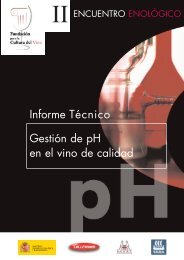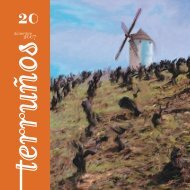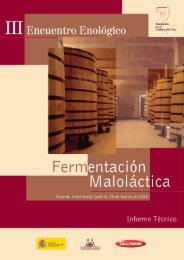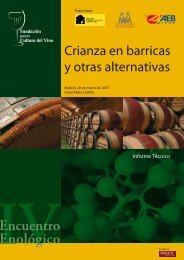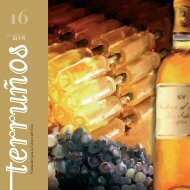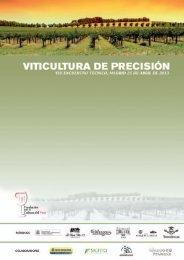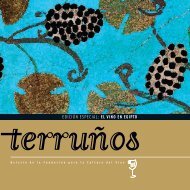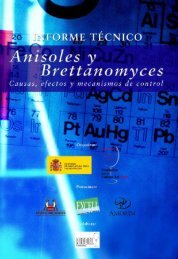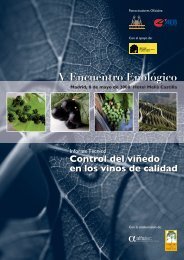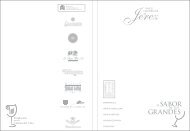Compuestos azufrados volátiles en vinos - Fundación para la ...
Compuestos azufrados volátiles en vinos - Fundación para la ...
Compuestos azufrados volátiles en vinos - Fundación para la ...
Create successful ePaper yourself
Turn your PDF publications into a flip-book with our unique Google optimized e-Paper software.
Seminario Técnico<strong>Compuestos</strong> <strong>azufrados</strong> volátiles <strong>en</strong> <strong>vinos</strong>ins known in the industry as EC1118, Pris de Mousseand PDM) – but were still fast at ferm<strong>en</strong>tation. The twonew strains metabolised a small portion of sugar insuch a way that it did not turn into ethanol (Table 1).It was also important to investigate other metabolites,since major distortions in their conc<strong>en</strong>trations mightaffect aroma or f<strong>la</strong>vour. Table 2 shows glycerol andacetic acid conc<strong>en</strong>trations in Chardonnay wines, ferm<strong>en</strong>tedusing commercial wine yeast strains. For allstrains, there was clearly a link betwe<strong>en</strong> ethanol andglycerol conc<strong>en</strong>trations. Higher glycerol was associatedwith lower ethanol. The major compon<strong>en</strong>t of vo<strong>la</strong>tileacidity, acetic acid, was not affected.The decrease in ethanol conc<strong>en</strong>tration might be smallcompared with the two ‘lowered ethanol’ prototypeyeast strains produced by the AWRI, but we are confid<strong>en</strong>tour ‘non-GM’ strategy is working.The AWRI’s technology should be capable of g<strong>en</strong>eratingstrains that are ev<strong>en</strong> lower in ethanol thanthose curr<strong>en</strong>tly avai<strong>la</strong>ble. For winemakers wanting totake control of high alcohol, innovation is driving theevolution of wine yeast in the right direction. Naturetook some 20 million years to evolve highly effici<strong>en</strong>tferm<strong>en</strong>tation yeast, we hope to reverse some of thisevolution in a re<strong>la</strong>tive blink of the eye!Acknowledgem<strong>en</strong>tsThe Australian Wine Research Institute, a member ofthe Wine Innovation Cluster in Ade<strong>la</strong>ide, is supportedby Australia’s grapegrowers and winemakers throughtheir investm<strong>en</strong>t body, the Grape and Wine Researchand Developm<strong>en</strong>t Corporation, with matching fundsfrom the Australian Governm<strong>en</strong>t.The authors wish to thank Rae B<strong>la</strong>ir and Sharon Mascallfor editorial assistance.Further readingDe Barros Lopes, M.; Eglinton, J.M.; H<strong>en</strong>schke, P.A.;Høj, P.B. and Pretorius, I.S. (2003) The connectionbetwe<strong>en</strong> yeast and alcohol production in wine: Managingthe double edged sword of bottled sunshine.Australian and New Zea<strong>la</strong>nd Wine Industry Journal18:27-31.Godd<strong>en</strong>, P.W. and Gish<strong>en</strong>, M. (2005) Tr<strong>en</strong>ds in thecomposition of Australian wine 1984-2004. In: B<strong>la</strong>ir,R.J.; Francis, M.E. and Pretorius, I.S. (ed) Advances inwine sci<strong>en</strong>ce – commemorating 50 years of The AustralianWine Research Institute, The Australian WineResearch Institute, pp115-139.Guth, H. and Seis, A. (2002) F<strong>la</strong>vour of wines: towardsan understanding by reconstitution experim<strong>en</strong>ts andan analysis of ethanol’s effect on odour activity of keycompounds. B<strong>la</strong>ir, R.J.; Williams, P.J. and Høj, P.B., (eds).In: Proceedings of the elev<strong>en</strong>th Australian Wine IndustryTechnical Confer<strong>en</strong>ce; 7-10 October 2001. Ade<strong>la</strong>ide,SA Australian, Australian Wine Industry TechnicalConfer<strong>en</strong>ce Inc.; pp128-139.J<strong>en</strong>son, I. (1997) Differ<strong>en</strong>ces in alcohol productionby various yeast strains: myth or fact? All<strong>en</strong>, M.; Leske,P. and Baldwin, G. (eds.) Advances in juice c<strong>la</strong>rificationand yeast inocu<strong>la</strong>tion: Proceedings of a seminar; 15August 1996; Melbourne, Vic. Ade<strong>la</strong>ide, SA: AustralianSociety of Viticulture and O<strong>en</strong>ology; pp24-25.Pa<strong>la</strong>cios, A.; Raginel, F. and Ortiz-Juli<strong>en</strong>, A. (2007)Can the selection of Saccharomyces cerevisiae yeastlead to variations in the final alcohol degree of wines?Australian and New Zea<strong>la</strong>nd Grapegrower and Winemaker527, 71-75.Piskur, J.; Rozpedowska, E.; Po<strong>la</strong>kova, S.; Merico, A.and Compagno, C. (2006) How did Saccharomycesevolve to become a good brewer? Tr<strong>en</strong>ds in G<strong>en</strong>etics22, 183-186.Textos asociadosSummary• Hot weather and mature fruit make high alcohol levels in wine more likely.• The 2008 vintage is set to hit a ‘sugar high’, with high levels of ethanol.• Winemakers want to keep alcohol under control for cost, taste and health reasons.• Sci<strong>en</strong>tists at the AWRI have pioneered a new, GM-free approach to ‘persuade’ yeast to produce less ethanol during ferm<strong>en</strong>tation.• Studies have shown that the maximum variation in ethanol levels from curr<strong>en</strong>t, commercial yeast strains is 0.5% v/v.• Innovation at the AWRI is driving the evolution of new, ‘low ethanol’ yeast in the right direction.85



